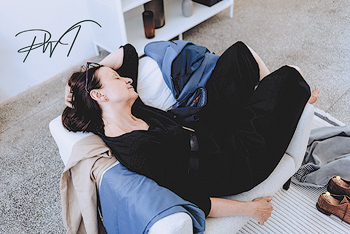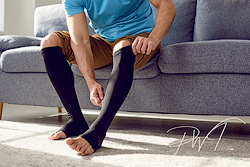|
In 2022, after her second bout with Coronavirus, 17-year-old Jenna started having unexplained episodes of dizziness. Sometimes she would pass out, sometimes throwing up at the same time. She also experienced episodes of constipation, anxiety, heart palpitations, brain fog, and bloating. She felt “hungry” for air all the time, even though her oxygen saturation was technically normal. Her symptoms were worsened by stress, hunger, or fatigue.
“What is wrong with my body?” Jenna exclaimed. Frustrated, and realizing all these perplexing symptoms weren’t going away, she decided to see her doctor, who in turn sent her to a specialist. She was eventually diagnosed with postural orthostatic tachycardia syndrome (POTS). She was told there was no cure, but her symptoms could be managed with a high-salt diet, wearing compression socks for the rest of her life, and eating small meals throughout the day.
As a result of these changes, Jenna hasn’t passed out in a year now. But she often comes close, she is still tired all the time, and the rest of her symptoms continue to disrupt her daily activities.
What is POTS?
POTS causes your heart to beat faster than normal when you change position from sitting or lying down to standing up. You may have symptoms immediately, or a few minutes later. Each person experiences POTS differently. Symptoms can include:
• Lightheadedness when standing up, standing in place for a long time, or on long walks
• Fainting/near fainting
• Forgetfulness
• Brain fog
• Racing heart rate
• Exhaustion
• Anxiety
• Shakiness
• Excessive sweating
• Shortness of breath
• Chest pain
• Headaches
• Feeling sick
• Bloating
• Pale face
• Purple discoloration of hands and feet if they’re lower than your heart
• Disrupted sleep
Like Jenna, people with POTS often notice their symptoms get worse:
• During periods of emotional stress
• In warm environments (including a hot bath or shower)
• Waiting in line
• During strenuous exercise
• During illness
• During your period
Where Did POTS come from?
Most people have never heard of POTS. Most who have heard of it did so after the year 2020. This is because a new trigger was introduced into the population: spike protein. Spike protein was engineered into both SARS-CoV-2 and each of the gene therapies that was supposed to end the pandemic. As recently as 2015, POTS affected only 1 in 20,000 Americans. Now it affects approximately 1 in 100. However, some authorities believe it is even more common than this since POTS is frequently misdiagnosed as anxiety, chronic fatigue syndrome, or “all in your head.”
After all, there is no blood test or x-ray that identifies the condition, so doctors—who did not learn about POTS in medical school—must know what they are looking for in order not to miss it. And few doctors have tilt tables in their offices to measure heart rate and blood pressure while changing a patient’s posture and position. It doesn’t help, either, that over 80% of POTS sufferers are women of childbearing age, whose symptoms and illnesses have historically been downplayed by a male-centric medical establishment.
Aside from spike protein, other less common triggers of POTS include:
• Significant illnesses, such as Mono
• Pregnancy
• Physical trauma, such as a head injury
• Surgery
• Autoimmune diseases such as Sjogren’s syndrome, lupus, and celiac disease
What Causes POTS?
Scientists have a few ideas, but nobody knows for sure why POTS happens. Some believe it stems from a loss of nerve supply to muscles in blood vessels. Others believe it is triggered by an overactive sympathetic nervous system, which is part of the Autonomic Nervous System (ANS). Reduced blood volume is another theory. Lastly, increasing evidence suggests it is an autoimmune disease, meaning that the immune system attacks healthy tissue for unknown reasons. In truth, any one or more of these causes may be responsible for POTS in a given person.
In any case, the final common pathway in POTS is failure of the Autonomic Nervous System to meet the body’s needs. The ANS is responsible for all the bodily functions you don’t have to think about: breathing, blood pressure, digestion, heartbeat, and so forth. Without a healthy ANS, whenever you sit or stand up, a large volume of blood would fall to your abdomen and legs, draining your brain. You wouldn’t be able to stand up without passing out every time. Fortunately, your ANS was designed to cause your blood vessels to instantly clamp down to keep too much blood from falling with gravity. Your heart pumps a little more forcefully and speeds up just enough to keep blood moving into and through your brain so you don’t miss a beat. With POTS, your ANS isn’t totally gone—that would be fatal—but it’s not quite up to par, either, leading to one or more of the many consequences of ANS dysfunction.
How Is POTS Treated?
According to experts, there is no cure for POTS, just as there is no cure for cancer, Alzheimer’s, depression, Parkinson’s, and so forth. This is because none of these conditions has a single cause. In a given person, multiple factors likely converge to trigger the development of POTS, just like the rest of these modern diseases.
 Following the medical model, doctors treating POTS recommend a number of symptom-reducing approaches. For example, individualized exercise programs may include reclined aerobic exercises, isometric exercises, walking, and yoga. Nearly all people with POTS will need prescription compression stockings. Most are prescribed high water intake, a high-salt diet (as much as 10,000mg sodium/day), small and frequent meals, and avoiding overexertion. Some are recommended to undergo counseling to help them learn to cope with a chronic health condition. And some people are prescribed one or more drugs to increase salt retention and blood volume, reduce heart rate, and constrict blood vessels. Following the medical model, doctors treating POTS recommend a number of symptom-reducing approaches. For example, individualized exercise programs may include reclined aerobic exercises, isometric exercises, walking, and yoga. Nearly all people with POTS will need prescription compression stockings. Most are prescribed high water intake, a high-salt diet (as much as 10,000mg sodium/day), small and frequent meals, and avoiding overexertion. Some are recommended to undergo counseling to help them learn to cope with a chronic health condition. And some people are prescribed one or more drugs to increase salt retention and blood volume, reduce heart rate, and constrict blood vessels.
As noted above, Jenna was able to function somewhat better by following the recommendations she was given by her symptom-oriented specialist. But she wasn’t satisfied with merely managing her disease, nor did she want her disease or its treatment to control her life for the next 80 years.
When Jenna came to Prestige Wellness Institute, we were not so interested in the diagnosis she was given as we were in the underlying disturbances going on in her body that were causing her problems. Bioenergetic testing revealed that she needed high-dose hypophyseal-pituitary-adrenal axis support, tightening of the gap junctions in her small intestines, and an autonomic nervous system reset.
When she returned for her second visit six weeks later, her fatigue was gone. Brain fog was gone. Dizziness was much better, occurring only when she stood still for extended periods. She was enjoying her rodeo competitions, unafraid of fainting while roping cows. After three years of misery, she couldn’t believe how quickly she got better simply by focusing on underlying causes of her POTS rather than on managing its symptoms.
If you have POTS and don’t want the rest of your life to revolve around it, call Prestige Wellness Institute at (435) 210-0184 in Utah County or (435) 259-4466 in Moab. Because you are unique, your treatment and recovery will not be identical to Jenna’s. But you might be surprised at how much better you can function and feel by taking a root cause approach.
And be sure to mention you read about it in Moab Happenings.
|
 Grand County Hospice, a service of Moab Regional Hospital, recently hosted a Death Over Dinner event — a unique gathering designed to help people talk openly about a topic that’s often avoided: death. The evening brought community members together over a shared meal to discuss what matters most when it comes to end-of-life care, personal wishes, and how we want to be remembered. Grand County Hospice, a service of Moab Regional Hospital, recently hosted a Death Over Dinner event — a unique gathering designed to help people talk openly about a topic that’s often avoided: death. The evening brought community members together over a shared meal to discuss what matters most when it comes to end-of-life care, personal wishes, and how we want to be remembered.
The event drew a wonderfully diverse group of attendees, with participants ranging in age from their 20s to their 80s — and even a few babies and toddlers. Volunteers noted how meaningful it was to see multiple generations come together to share stories, ask questions, and explore what it means to live fully through every stage of life.
“It was a beautiful evening,” said Lisa Monson-Potter, Director of Grand County Hospice. “Everyone who came brought their own experiences and questions, and we all learned from one another. It really showed how much our community values compassion and connection.”
Death Over Dinner is a nationwide movement that turns a difficult subject into an opportunity for meaningful conversation. Participants share stories, reflect on experiences, and explore how planning ahead can bring peace of mind for themselves and their loved ones. By discussing preferences for medical care, memorial services, and legacy planning, people of all ages can help ensure their values and wishes are honored when the time comes.
 Talking about death doesn’t have to be uncomfortable. In fact, these honest conversations often lead to a deeper appreciation for life and stronger connections with family and friends. When we speak openly, we’re more likely to receive care and support that truly reflect who we are and what matters most to us. Talking about death doesn’t have to be uncomfortable. In fact, these honest conversations often lead to a deeper appreciation for life and stronger connections with family and friends. When we speak openly, we’re more likely to receive care and support that truly reflect who we are and what matters most to us.
Grand County Hospice supports patients and families through life’s final chapter, offering compassionate medical care, emotional support, and guidance with practical arrangements. Its dedicated team helps ensure comfort, dignity, and peace for both patients and their loved ones.
To learn more about hospice services or future community events, visit mrhmoab.org/hospice or call 435-719-3772.
And be sure to mention you read about it in Moab Happenings.
|